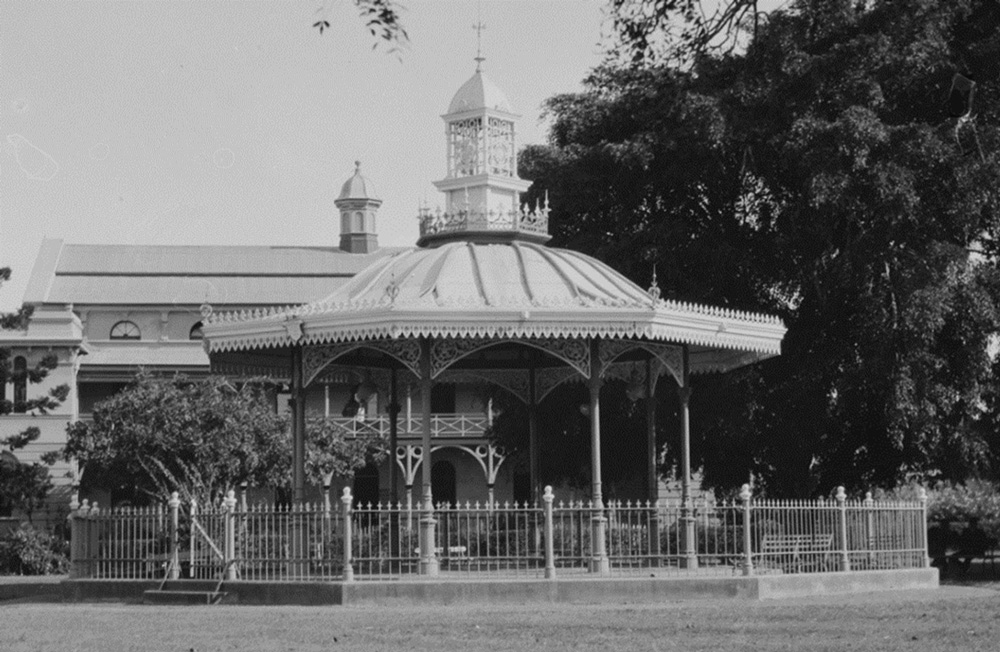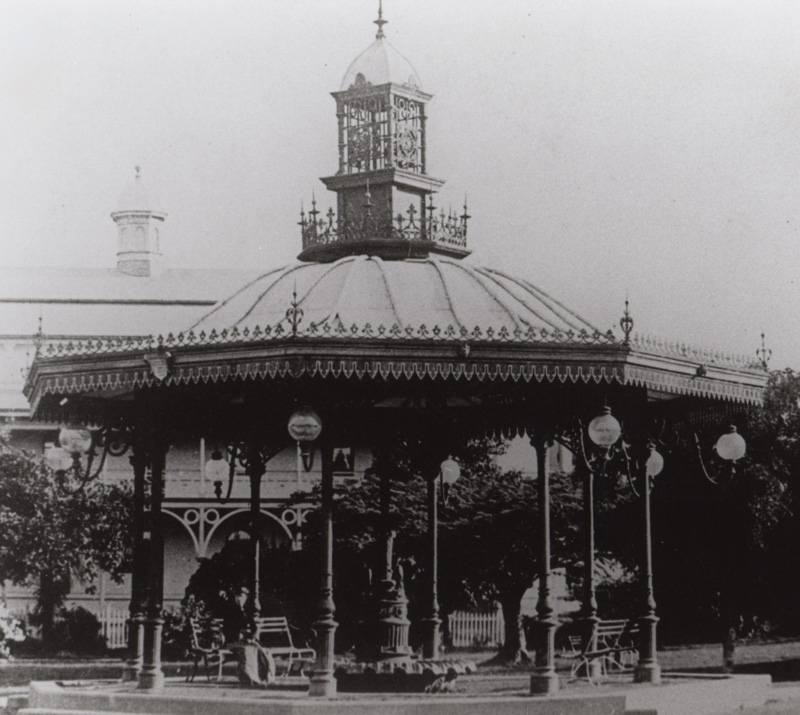To shade a memory
Photo: The Melville fountain in its original location. Image courtesy of the Maryborough Wide Bay & Burnett Historical Society.
Melville Fountain & Pavillion
When Andrew Wedderburn Melville, former Mayor of Maryborough, died in 1882 his beloved sister, Janet, inherited most of his fortune. Both of them had emigrated from Scotland to Australia in 1849. On her death in 1888, amongst other significant local legacies, she left £500 for the erection of a fountain in the Botanical Gardens (Queens Park) in her brother’s memory.
One of the trustees of her estate, local member Andrew H Wilson, visited the UK and brought home a number of designs of elegant fountains centred in ornamental arbours or pavilions. The fountain chosen by the trustees of the gardens and two executors of the Melville estate, was believed to be one greatly admired when exhibited at the Glasgow International Exhibition in 1888.
This fountain with its covering structure arrived in Maryborough in late December 1889 and was erected early the following year. The total cost had gone over the bequest by £100. Of note is the memorial plaque, which incorrectly shows the date of erection as 1889, possibly due to it being cast at the same time as the covering pavilion but not factoring in the long shipping time to Australia from Scotland.
The design of the ornate cast iron fountain consisted of a large basin, which from its centre rose a large column with griffin heads around a lower cap. Those heads spouted water from their mouths into the basin. Above this cap three cranes looked skywards while further up a narrower leaf clad column rose to a funnel shaped tier out of which sprung another similar but smaller design. In the centre of the top funnel a golden cherub clasped a horn of plenty from which a jet of water was thrown upwards.
The associated covering pavilion comprised a cast iron ogee (double) curved roof supported on decorative cast iron columns bedded in a plinth with concrete edging. Topping it was a large extremely decorative cupola rising to an ornate finial. Originally ornate cast decorative crestings ran along the lower edges of the roof while angular iron lacework hung below it and cast lions’ heads drained the gutter. Unfortunately, these have not survived to the present day. Its illumination came from gas lamps, contained in large etched glass spheres, mounted on cast iron arms from each of the pavilion’s columns. Electric lighting superseded these in the early part of the 20th century.
The shelter and the fountain proved not to be a happy marriage as the fountain, made by George Smith & Co (Sun Foundry) turned out to be too big for the covering pavilion, manufactured by W MacFarlane & Co. With the water turned on, the top jet of the fountain sprayed water on to the inside of the pavilion roof.
One story goes that at the opening ceremony, when officially demonstrated, the fountain drenched the VIP guests present, much to the amusement of some of the ‘lower orders’ in attendance.
Around this time there had also been a request for the construction of a band stand for performances to be held in the gardens.
A solution to these two issues happened five years later, with the fountain being moved out of the pavilion northwards to the centre of the round flower bed about 30 metres distant.
Also added at this time was a surrounding new decorative iron fence around the pavilion. That structure could now be used as a much needed performance space and then became known generally as the rotunda but sometimes referred to as the band stand or band rotunda. The fountain could also be admired and function properly.

The Melville Pavilion (Rotunda) without its fountain and with its new fence. Image date circa late 1920s.
Perhaps the most memorable events in this era involving the rotunda came with the city celebration marking the ending of World War 1. Just one day after the signing of the Armistice, a large civic procession started in the morning at the Town Hall green and proceeded to Queens Park, gathering at the decorated rotunda for a thanksgiving service. An unexpected ‘extra’ being the hanging and burning of an effigy of the Kaiser by members of the Naval Band after sentence on him had been pronounced earlier in the day by the mayor.
Such was the City’s fervour at that time that the procession was repeated that night with a conservative estimate of 5,000 people forming the crowd. They arrived to a brilliantly lit rotunda decked in flags. Returned soldiers formed a cordon inside the railings while bands played, speeches were made and hymns sung; with the finale being the singing of the National Anthem.
A major issue with using the rotunda proved to be the height of its performance area. Public viewing of speakers or band members proved difficult as its floor sat almost at ground level. Although recognised for years this problem was finally overcome in 1932 with the building of a new floor for the rotunda 625 mm (2’6”) higher than the old one. The actual structure itself was not raised as part of this action with the new floor covering the bottom section of the columns.
This significantly enhanced the useability of the structure. Over the years the rotunda has been used for performances, speeches, meetings, raffle draws, etc. to name just a few of its functions.
After nearly 100 years of use both the rotunda and the fountain were sadly showing their age. Major repairs were done to both items in 1987 for an Australian bi-centennial project by the Maryborough City Council and local firm, Olds Engineering.
The fountain, which had not worked for years was given a major rebuild, then recommissioned. Unfortunately, when turned on, wind created a large wet area of ground beside it. To overcome this a low circular concrete block wall with an inner concrete floor were built. Associated with this, outer stone-faced flower beds were constructed around the fountain with this in turn partly surrounded by a brick path instigated by the Rotary Club of Maryborough City with the names of local people, who purchased a brick, fired into them. Locally it has become known as the ‘fairy fountain’ but the origins and when that started to be called by that name is unclear.
The rotunda received a rebuilt cupola and finial, together with a much needed repaint and general tidy up.
Today, the Excelsior City Band plays in the rotunda on the last Sunday of every month while families ride on the miniature MELSA trains or catch a ride on the Mary-Ann, a replica of Queensland’s first steam locomotive.
Thanks to the Maryborough Wide Bay & Burnett Historical Society and the Maryburrowers history group for their contributions to this story.

